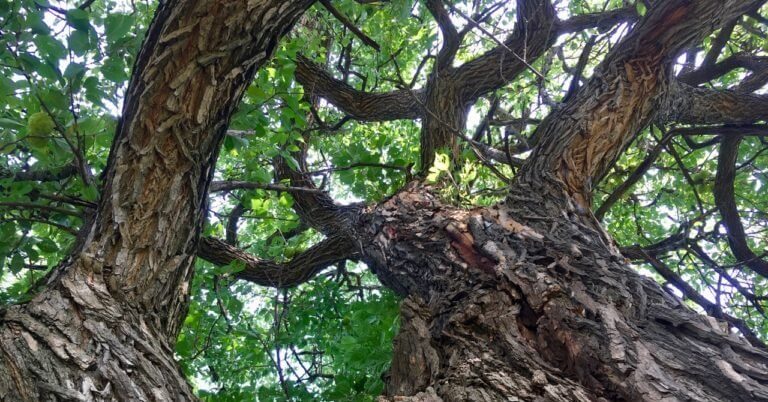Root rot is one of the most destructive diseases that can afflict trees and plants. It occurs when the roots of a tree are exposed to excessively wet or damp soil, leading to fungal infections that cause the roots to decay. If left untreated, root rot can severely damage or even kill your trees, making it a critical issue for homeowners and landscapers to address. In this article, we will explore how to identify root rot, how to fix it, and most importantly, how to prevent it from occurring in the first place.
How to Spot Root Rot
Catching root rot early can save your trees, but it can be tricky to spot because it looks like other problems. Here are some signs to look out for:
- Slow Growth: If your tree isn’t growing as fast or as full as others, its roots might be in trouble.
- Wilted Leaves: Leaves might look wilted even if the soil is wet because the damaged roots can’t get enough water and nutrients to the rest of the tree.
- Yellow or Brown Leaves: Leaves turning yellow or brown, especially at the edges, can be a sign of root rot since the roots can't deliver essential nutrients.
- Early Leaf Drop: If your tree starts losing its leaves earlier than usual, it could be a sign that the tree is stressed due to root rot.
- Dying Branches: In later stages, you might notice branches dying back from the tips, which indicates the roots can't support the tree’s upper parts.
- Mushy or Dark Roots: If you can check the roots, look for mushy, soft, or dark-colored roots. Healthy roots should be firm and light in color.
- Fungus at the Base: Fungal growth, like mushrooms around the tree's base, can also indicate root rot.
How to Fix Root Rot
If you notice root rot, act quickly to save your tree. Here's what you can do:
Improve Drainage
Poor drainage is the main cause of root rot. If water pools around your tree, you need to fix the drainage. Add compost to the soil or adjust the area so water flows away from the roots.
Trim Affected Roots
- Carefully expose the roots and cut away the soft, rotting ones using clean pruning shears.
- Be gentle to avoid harming the healthy roots.
- Throw away the infected roots to stop the disease from spreading.
Water Less
If you’re overwatering, cut back. Make sure the tree gets enough water without creating soggy conditions that lead to rot. It's better to water deeply and less often than to water frequently but shallowly.
Use Fungicides
Fungicides can help stop root rot, especially early on. But they aren’t a complete solution—use them alongside improving drainage and watering less.
Transplant If Needed
If the tree is small and the root rot is severe, consider moving it to a better-drained location. Make sure the new spot has well-drained soil and be careful not to overwater as the tree settles in.
How to Prevent Root Rot
Prevention is always better than cure, especially when it comes to root rot. Here are some steps you can take to protect your trees from this destructive disease:
Plant in Well-Drained Soil
Choose planting sites with well-drained soil to prevent water from pooling around the roots. If the natural drainage is poor, consider raising the planting area with a berm or installing a French drain to divert water away from the roots.
Avoid Overwatering
One of the most common mistakes homeowners make is overwatering their trees. Make sure you’re providing just the right amount of water. Most trees prefer deep watering less frequently rather than shallow watering often.
Monitor Soil Moisture
Regularly check the moisture level of the soil around your trees. You can do this by inserting a finger or a soil moisture meter into the ground. The soil should be moist but not soggy.
Mulch Properly
Mulching can help retain moisture in the soil, but too much mulch or improperly applied mulch can cause issues. Apply mulch in a thin layer and keep it away from the trunk of the tree to allow for proper air circulation.
Choose Resistant Varieties
If you’re planting new trees, consider choosing species or varieties that are resistant to root rot. Consult with a local arborist or tree nursery to determine which trees best suit your area’s conditions.
Regular Inspections
Regularly inspect your trees for any signs of stress or disease. Early detection of issues like root rot can make the difference between saving and losing a tree.
Contact Strobert Tree Services
If you suspect your tree may be suffering from root rot or you want to take proactive steps to prevent it, contact Strobert Tree Services. Our expert arborists have the knowledge and experience to diagnose and treat root rot, as well as handle all of your tree care needs, including pruning and maintenance. Serving Delaware, Pennsylvania, and New Jersey, we are committed to keeping your trees healthy and thriving. Don’t wait until it’s too late—reach out to Strobert Tree Services today to protect your landscape from the devastating effects of root rot.











